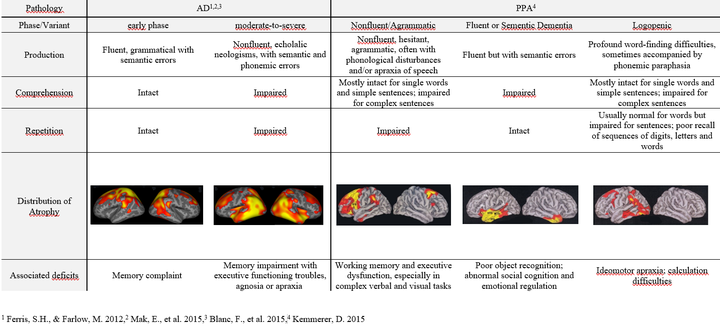Alzheimer, MCI and PPA: language disorders analyses and their anatomical bases
 Psychopathological profiles of MA phases and PPA variants
Psychopathological profiles of MA phases and PPA variants
Patients with Alzheimer’s disease not only exhibit memory problems but may also manifest difficulty in finding the right word for objects or pictures at early stages of the disease. However, these symptoms often represent the early manifestation of another dementia syndrome, a semantic variant of Primary Progressive Aphasia (PPA-SV).
The general goal of this research proposal is to better understand and differentiate between the nature of these language deficits and the anatomical features of these patients. To achieve this goal, a set of experimental language measures and sophisticated imaging approaches will be combined. This represents a fundamental challenge in the field of Alzheimer’s disease and related dementia research.
In fact, understanding the nature of the language deficits in diseases of dementia may be beneficial for :
- developing specific language rehabilitation programs
- recommending communication strategies for caregivers and family members to improve social interactions
The general goal of this project is to demonstrate that the automatic quantitative analysis of 2-3 minutes of connected speech elicited by picture description represents a valuable tool for characterizing language production deficits 1. in individuals with mild cognitive impairment (MCI) and for supporting their early identification, and 2. in patients with dementia (Alzheimer and primary progressive aphasia - PPA) for differential diagnosis.
We propose to conduct an automatic quantitative analysis of connected speech samples elicited by picture description provided by databases of connected speech such as the Canadian Consortium on Neurodegeneration in Aging (CCNA, http://ccna-ccnv.ca/) (Drs Philips and Chertkow) and the Memory and Aging Center of UCSF (Drs Gorno-Tempini and Miller) using cutting-edge approaches from computer science and artificial intelligence.
Moreover, we will use the language production profile obtained using the connected speech analysis to predict the pattern of brain damage in terms of atrophy and functional network disruption.
Collaborators
- Dr Nathalie Bier, Montréal
- Dr Howard Chertkow, Montréal
- Dr Maria-Luisa Gorno-Tempini, San Francisco
- Dr Philippe Langlais, Montréal
- Dr Karine Marcotte, Montréal
- Dr Bruce Miller, San Francisco
- Dr Natalie Phillips, Montréal
- Dr Elizabeth Rochon, Toronto
- Dr Isabelle Rouleau, Montréal